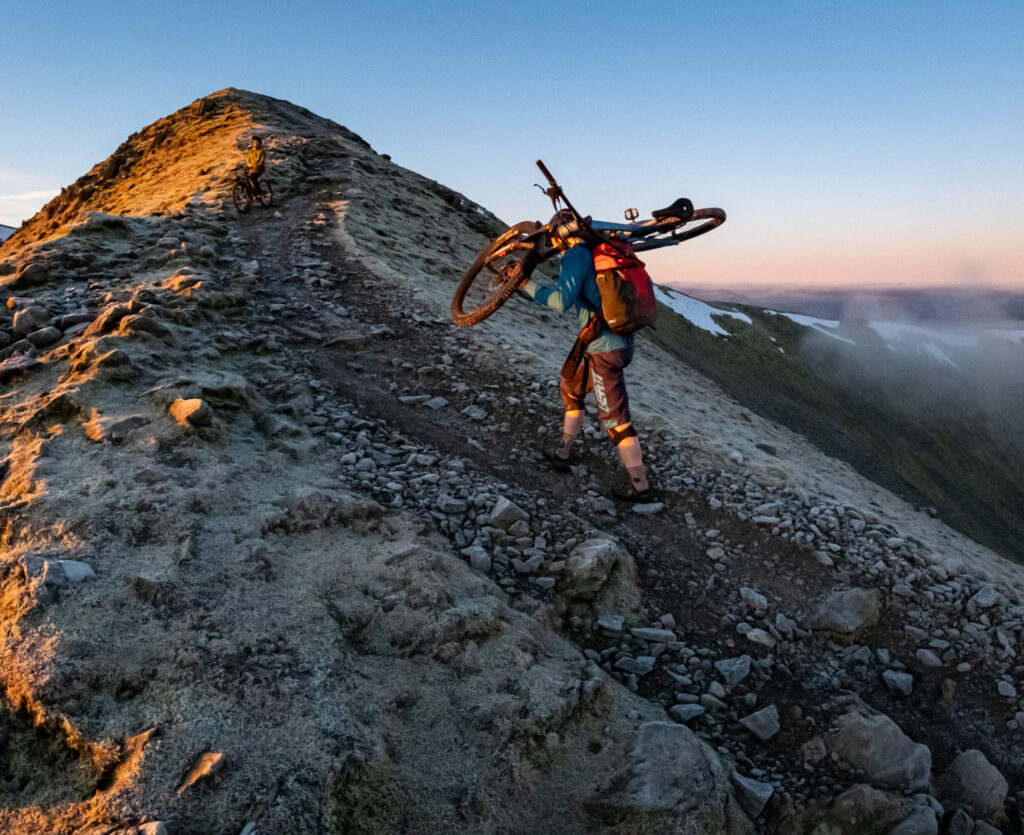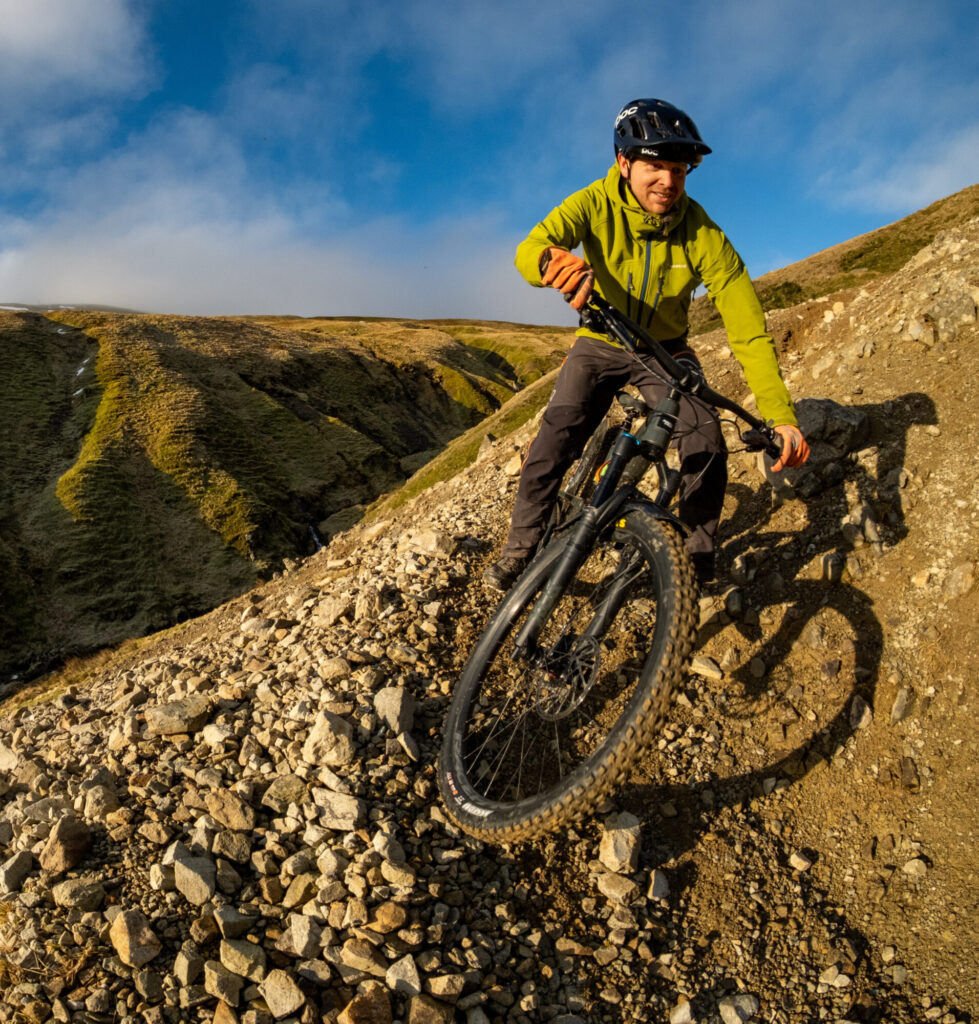The glaciated peaks of the Helvellyn range offer panoramic views across their surrounds. Lying between some of the Lake District’s most beautiful bodies of water; Ullswater, Grasmere and Thirlmere, it’s no wonder a hike of Helvellyn was voted Britain’s most popular walk. With multiple possible approaches to suit everyone’s version of an adventure, Helvellyn offers spine-tingling scrambles, high-octane mountain bike trails, harsh winter ascents and – when the conditions are right – some of the best skiing in England.
‘Legend and poetry, a lovely name and a lofty altitude combine to encompass Helvellyn in an aura of romance; and thousands of pilgrims, aided by its easy accessibility, are attracted to its summit every year. There is no doubt that Helvellyn is climbed more often than any other mountain in Lakeland, and, more than any other, it is the objective and ambition of the tourist who does not normally climb.’ – Alfred Wainwright
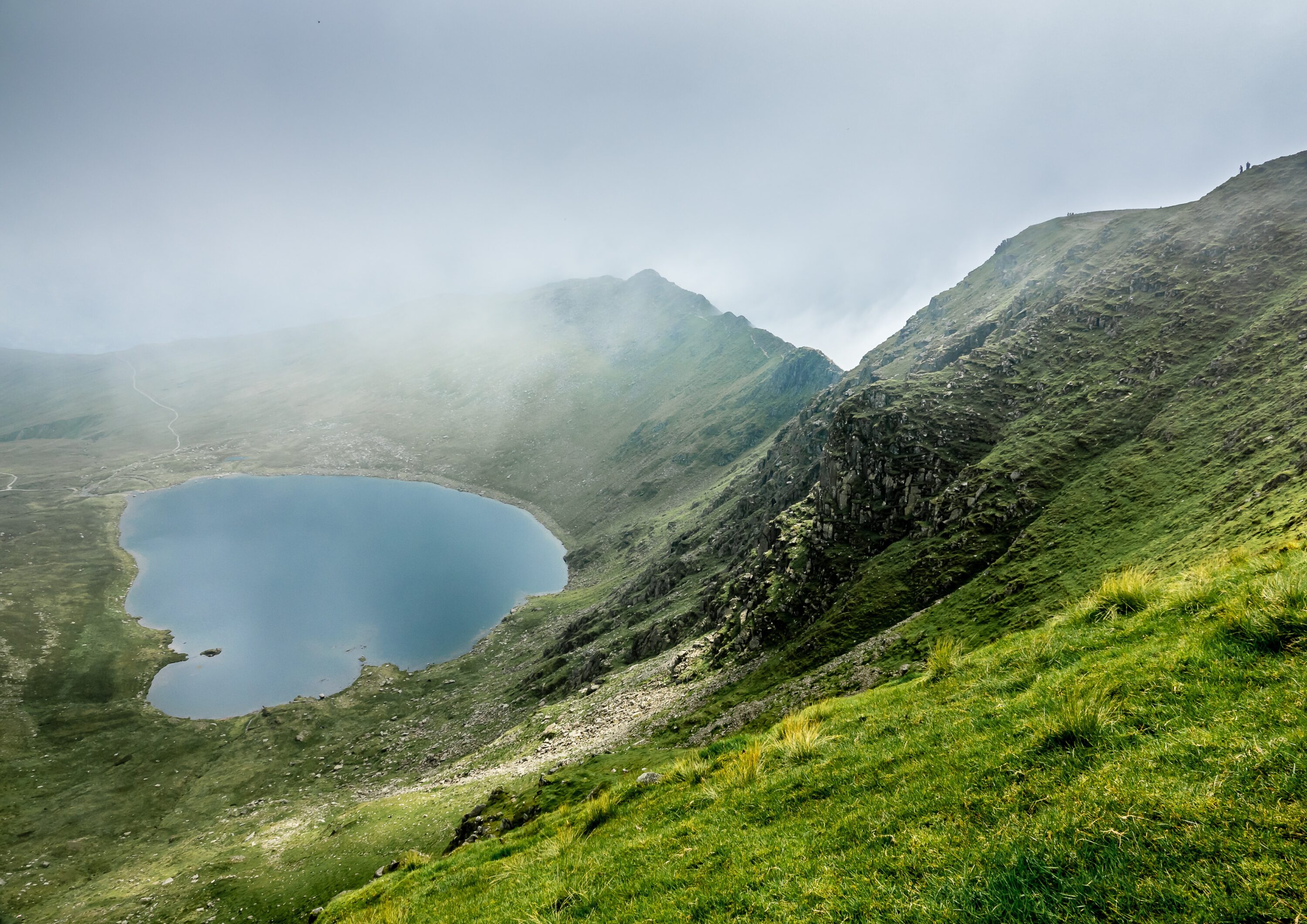
Looking down onto Red Tarn from Helvellyn summit. © James Armes
Meet the Mountain
A firm favourite with peak-baggers chasing Wainwrights or Birketts and locals alike, Helvellyn is one of England’s most iconic mountains, perhaps even eclipsing its Lakeland neighbour, the country’s highest, Scafell Pike in popularity. It’s true that you’re unlikely to get the summit to yourself at midday in high season, but the aura of romance recalled by Wainwright still in abundance on this peak, regardless of how many you’ll be sharing it with.
At 950m at its highest point, Helvellyn is the third highest peak in both England and the Lake District. Helvellyn’s height is surpassed only by the aforementioned Scafell Pike at 978m and its sister peak, Scafell, at 964m. Helvellyn is a significantly more accessible peak comparatively, though its terrain is challenging enough to get your heart pumping and your thighs burning – you’ll feel like you’ve really earned that pint of Wainwright by the end of the day.
Hiking Helvellyn can be done via a number of different routes, some steeper than others, though none are to be taken lightly. Approaches typically start from the village of Glenridding on the shore of Ullswater, or from Thirlmere. The latter is thought to be the less picturesque route up, but is still worthwhile and a far gentler incline for those less partial to an uphill slog! Incorporating one or both of possibly the Lake District’s most famous ridges, Striding Edge and Swirral Edge, is also an option for those comfortable with exposure and scrambling (more on this later), and a sandwich stop by Red Tarn is a must.
Helvellyn’s appeal isn’t solely the reserve of the rambler, or even the fell runner, the peak is also a firm favourite with the bolder mountain biker, offering hike-a-bike trails and hair-raising downhills. A photographer’s paradise too, a sunrise ascent will often provide exceptional views of Ullswater, cloud inversions and breathtaking lightplay on the mountain’s craggy features (it’s also an excellent way to dodge the crowds).
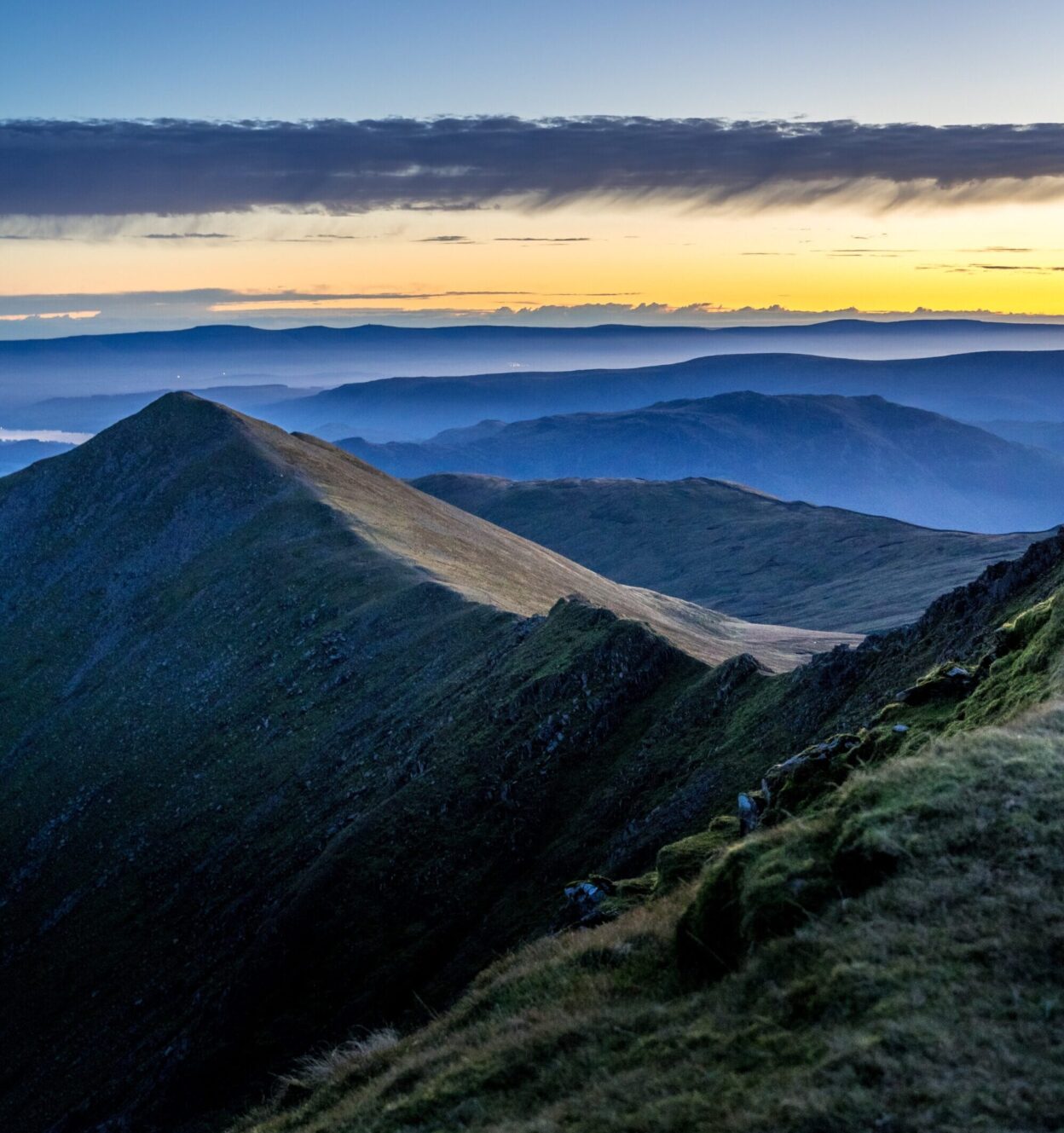
Sunrise from the summit. © Jonny Gios
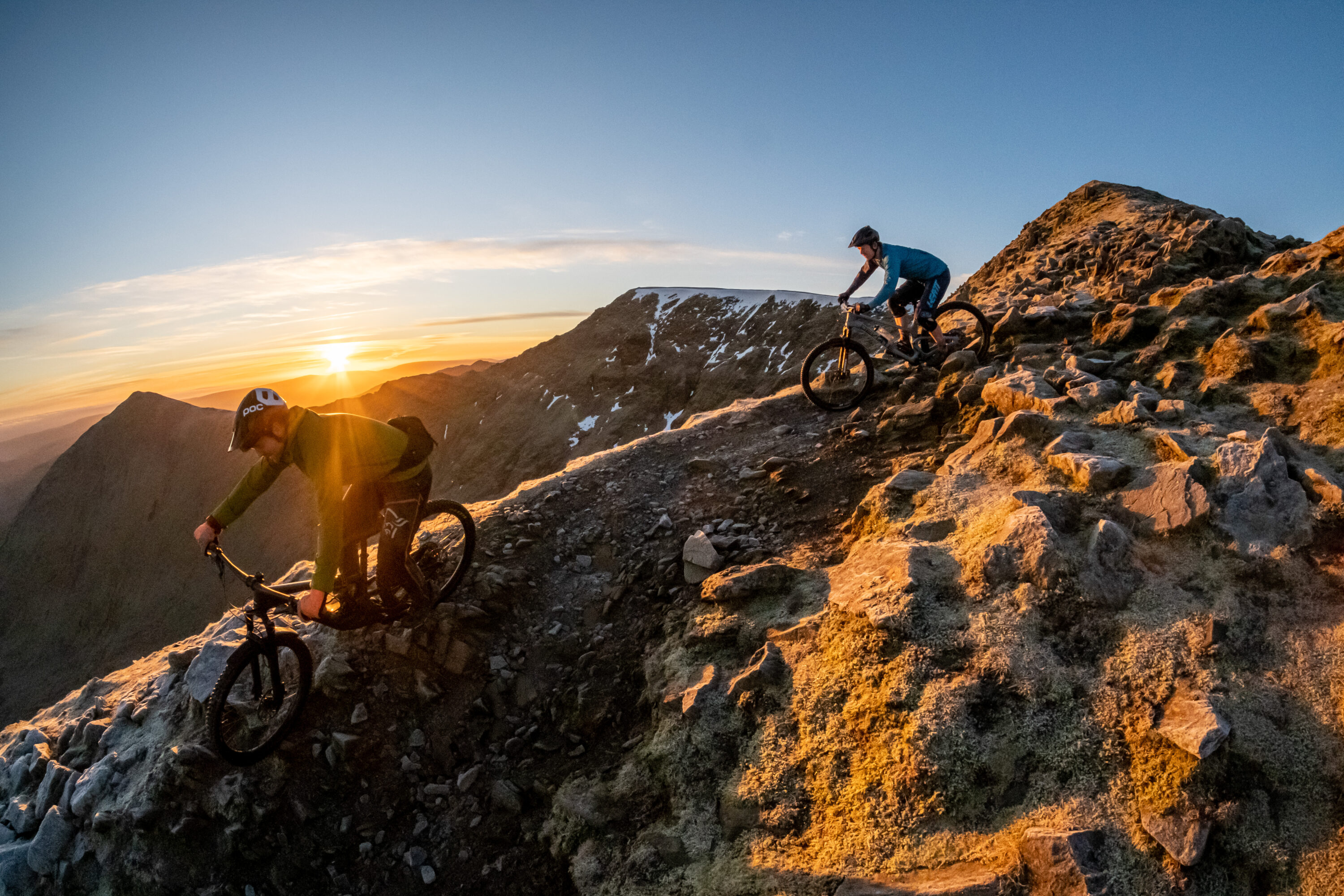
Golden hour on Helvellyn. © Nils Amelinckx
A brief history of Helvellyn
Helvellyn’s history is pretty colourful and there are a few interesting markers of significant events to look out for.
Helvellyn is around 450 million years old and is part of the Borrowdale Volcanic Group. No, that’s not a club for lava-lovers, but rather a group of rock formations created by a major volcanic eruption. Glacial movement during the last ice age (over 20,000 years ago) then carved Helvellyn’s most notable features, including the two prominent ridge lines leading to its summit, Striding Edge and Swirral Edge.
It’s likely that Helvellyn’s name derives from the old Cumbric language, which was widely spoken in Northern England and Lowland Scotland up until the 12th century. It’s believed that the mountain’s name loosely translates to ‘yellow moorland’, a combination of two Cumbric words; hal, meaning moorland and velin, which means yellow. This name is likely to have been coined by shepherds of the time, who would assess the quality of grazing land for their herds based on the appearance of the grass. Owing to its elevation, snow on Helvellyn will often linger into the late spring, and the grass that grows beneath it takes on a yellow shade.
Helvellyn’s history is pretty colourful and there are a few interesting markers of significant events to look out for. Famed as the first mountain summit in Britain to host a plane landing, and the setting for a tragically true story of a perished painter whose body was guarded by his faithful terrier Foxie, monuments to both events can be found by walkers with a keen eye.
Less subtle is the cross-shaped, stone summit shelter which was built by volunteers around 60 years ago. The shape of the shelter means that walkers can take refuge in any wind direction, and it is a much-used bolthole for sandwich-eating on sunny days and survival when conditions change rapidly.
Helvellyn is also the subject of numerous works of poetry, painting and literature and more recently featured in the BBC documentary film series Life Of A Mountain.
Know before you go
Helvellyn is without a doubt, a must-do for well-prepared walkers. Assess your fitness levels and ability first, consider your kit, give yourself plenty of time to complete your route in daylight hours (unless you are comfortable with a headtorch descent), and of course, factor in those all-important snack stops and photo opps.
Choosing the most suitable route for you and your party is the first step in making sure everyone summits safely, and it’s important to remember that conditions ‘on the ground’ are very unlikely to match up to those on the tops. It takes an awful lot of rain to keep those lakes full you know, and you’re unlikely to catch a Cumbrian without a cagoule close to hand. Is it a glorious, warm, sunny day on lower ground? Depending on windspeed and direction and owing to its elevation, there’s a really good chance you’ll be feeling the chill up high. The weather on Helvellyn is notoriously changeable – pack your rucksack accordingly!
On the subject of weather, to get the most accurate idea of how things will feel once you’re up there, take a look at the Mountain Weather Information Service forecast and Lake District Weatherline, which are both freely accessible online. The latter is run by the Fell Top Assessors team, Jon Bennett, Zac Poulton and Wes Hunter. Every day through December – March, one of these guys makes their way up the mountain to check conditions, take photos and supply a report to add to the Met Office weather forecast. As winter mountaineering aficionados, it’s safe to say they know their stuff.
There are no bins or toilets on Helvellyn – or on pretty much any mountain, anywhere, for that matter –so be prepared to carry anything you carry up with you back down again. ‘Go’ before you go (you know what I mean!), don’t start fires or have barbecues and leave that aura of romance that Wainwright was talking about in tact for the next people to enjoy.
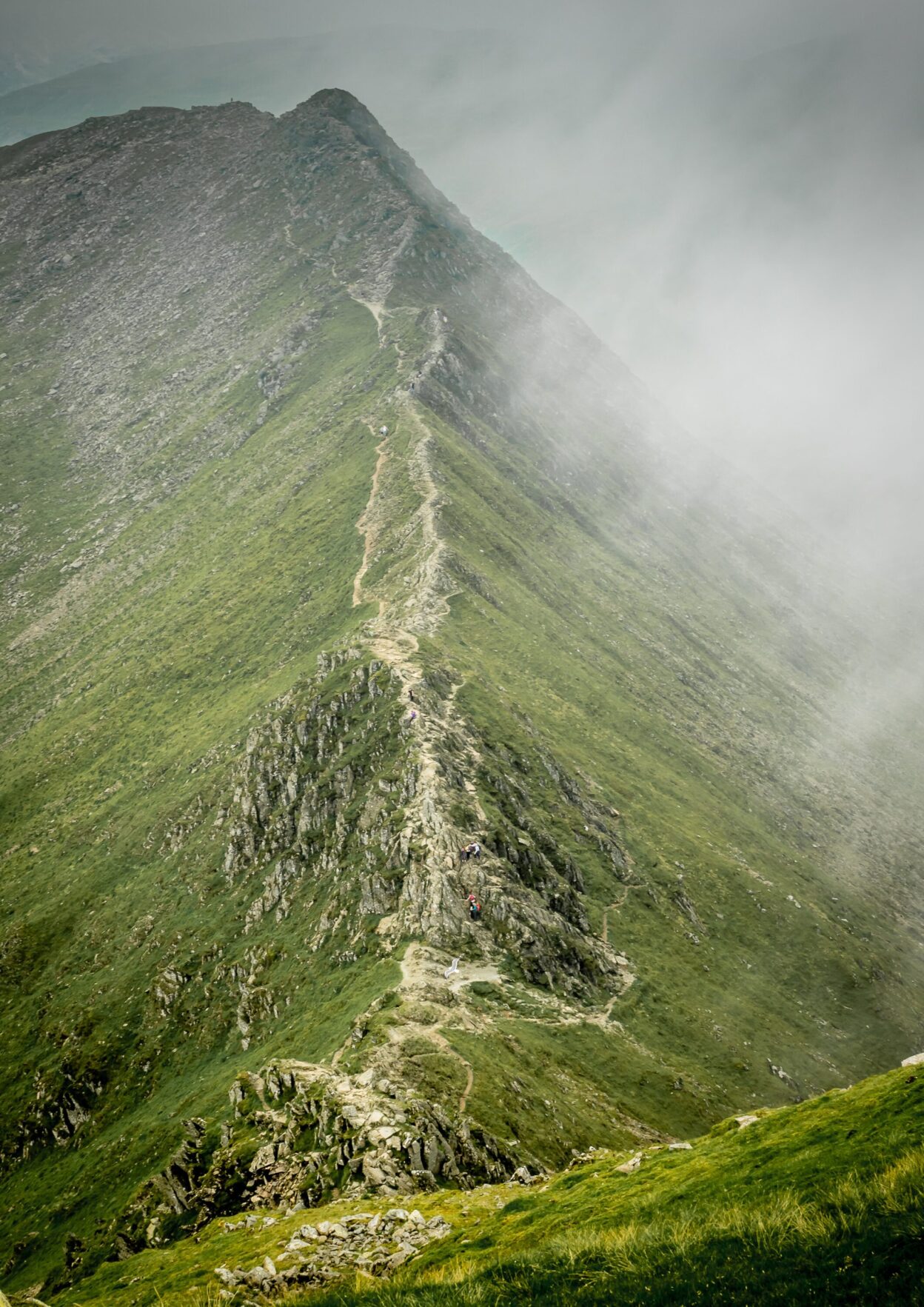
Amble or scramble?
Striding Edge and Swirral Edge scramble
This route covers 8.11 miles in distance and 2,575 feet of elevation and should take around 5 hours depending on your pace. These two knife-edge ridge lines are a spectacular way to ascend Helvellyn, you can incorporate one or both of them into your route, though forethought is advised. In a previous life, working at a busy Lake District youth hostel, I was often asked by first-time guests:
‘Is Striding Edge safe?’
Whether or not any mountain route is safe is very much subjective to you. Striding Edge is a notorious spot for slips and trips, often resulting in Mountain Rescue call-outs and occasionally in fatalities, but with a little caution and planning, can be an awesome addition to a big day in the hills for surefooted fell walkers.
Both of Helvellyn’s ridges require a degree of scrambling. So what exactly is scrambling? Bridging the gap between walking and climbing, scrambling involves using both your hands and feet, down-climbing and negotiating steep sections of rock. Taking on Striding and Swirral Edge means traversing boulders and narrow walkways with a sheer drop at either side that will give even those with a strong head for heights (myself included) a touch of butterflies.
So, assess your ability, and play to the conditions. The ridges become slippery when wet, and strong winds can easily knock you off balance. Appropriate footwear is essential, and bear in mind that queues can form on Striding Edge as people negotiate the infamous ‘bad step’. It’s tricky and potentially dangerous to others to attempt to reverse, so make sure you’re sure before you commit!
Both Striding and Swirral Edge are Grade I scrambles and are very simple to navigate – if you’re not following people, you’ll be following the line of polished rock. Striding Edge is renowned for being one of the UK’s best of its grade. In good, dry conditions, both lines are technically suitable for a beginner scrambler and are a really exciting addition to your ascent if you are feeling confident and capable. Swirral Edge is arguably a little more easy-going, and is often taken as the second ridge in a horseshoe route.
Both of Helvellyn’s ridges require scrambling, that is, using both your hands and feet in a way that bridges the gap between walking and climbing.
Thirlmere Amble
Regarded by some as Helvellyn’s less glamorous side, Thirlmere has its own moody charm
The quickest route up Helvellyn involves around 2.3 miles of trail, 2,475 feet of elevation, and is manageable in 3 hours, again depending on your pace. If you don’t have a head for heights, this alternative approach to the summit climbs a pleasant but stony track from the mountain’s west side at the southern end of Thirlmere. Following Helvellyn Gill offers plenty of toe-dipping opportunities along the way and means that you can give the ridges a miss and still enjoy a day in the fells that will certainly earn you an ice cream. To return, simply retrace your steps.
There are options to make this into a circular hike too, descending via Wythburn’s zig-zag path will add an extra few hours to your day but is much gentler on the knees!
Regarded by some as Helvellyn’s less glamorous side, Thirlmere has its own moody charm, and the starting point is easily accessible by public transport. Approaching the mountain from Thirlmere offers views to the north over the Skiddaw range. Whilst these routes eliminate the lofty ridge lines and are shorter in distance, they are steep, so be prepared to put in some work and allow yourself plenty of time.
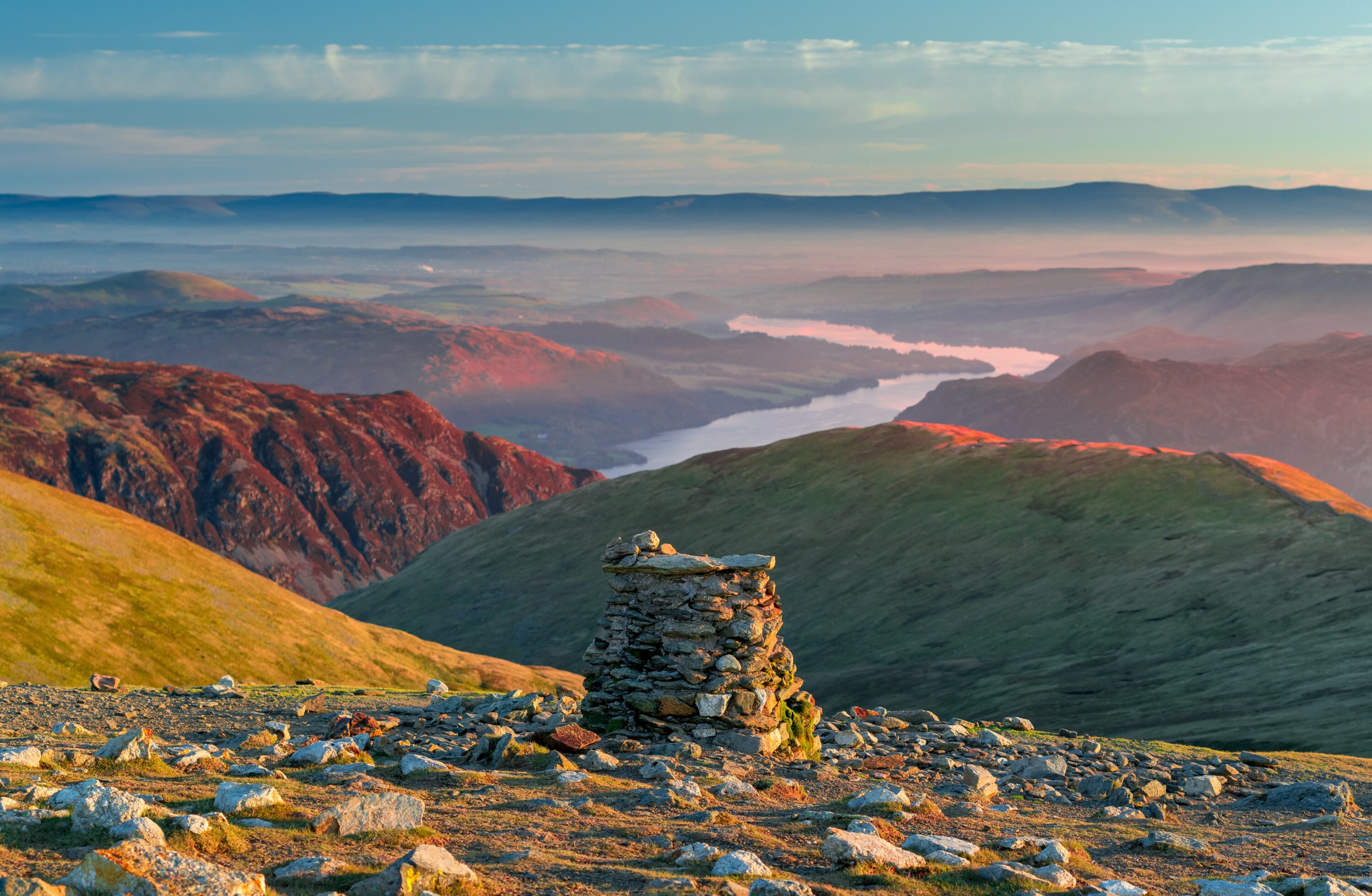
© Jonny Gios
When is the best time to climb Helvellyn?
Whilst most will opt for a spring or summer ascent of Helvellyn, it is possible for winter sports enthusiasts to summit in the colder months. Spring and summer offer fairer temperatures and longer daylight hours for the everyday adventurer, but in the depths of winter, experienced mountaineers and climbers can take on some of the mountain’s gullies and ridges and there are around nine ski runs up to a mile in length.
Even the most benign-looking frost can render steep ridge lines totally treacherous and temperatures typically decrease by around 1˚C per 100m of ascent
Tackling Helvellyn in the colder months requires a good winter skillset, and should only be attempted by experienced skiers and winter walkers, equipped with winter boots, ice axes and crampons. Even the most benign-looking frost can render steep ridge lines totally treacherous and temperatures typically decrease by around 1˚C per 100m of ascent.
In unpredictable conditions it’s incredibly important to be aware of procedures for self-rescue, and taking a winter skills course is advisable for anyone wanting to get in on the action all year round. Fell Top Assessors run these exact courses on Helvellyn itself!
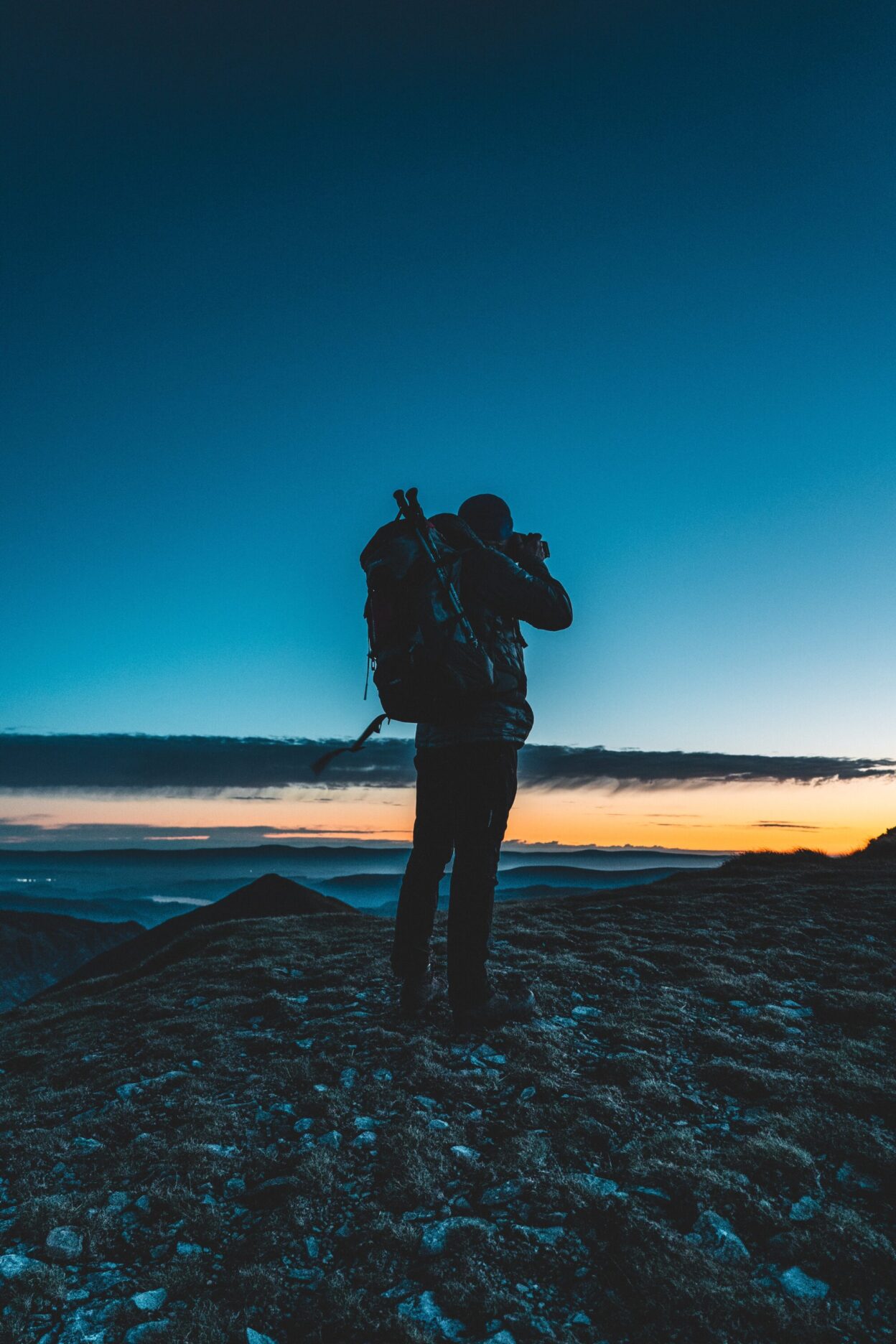
Winter conditions present different challenges on Helvellyn. © Jonny Gios
Can you ride up Helvellyn?
experienced bikers can enjoy testing climbs up steep switchbacks and rough, rugged and gnarly downhills
Well, probably not the whole way! Most of Helvellyn’s MTB routes involve sections of hike-a-bike, that is, pushing or shouldering your steed and carrying it uphill.
Helvellyn has the honour of featuring one of England’s highest bridleways, and experienced bikers can enjoy testing climbs up steep switchbacks and rough, rugged and gnarly downhills covering sections of the mountain such as Sticks Pass, Dolywagon Pike and Grizedale. Helvellyn is widely regarded as having some of the best riding the Lakes has to offer, though it isn’t a beginner’s venue. Competent riders can take the pressure off by booking a guide who can assist with navigation, preparation and proper bike setup for Helvellyn’s very specific terrain.
As with walking, there are approaches to the summit from both the east and west sides of Helvellyn, but for an truly otherworldly experience, head for the east-facing trails in the early hours for a chance to catch the sunrise and awe-inspiring cloud inversions, then descend in the glow of golden hour.
Now you’ve had the low-down on Helvellyn, it’s important to remember that access to these incredible adventure playgrounds is a privilege, and it is our responsibility to treat them with respect and minimise our impact wherever possible. Information on ethics, conservation and restoration is widely available online, and it’s super simple to be an informed and mindful mountain enthusiast. The Glenridding Common area which includes the summit of Helvellyn, Striding Edge and Swirral Edge and is a Special Area of Conservation managed by the John Muir Trust. You can check out the British Mountaineering Council’s free Green Guides to areas like the Lake District, learn about and support the work of organisations such as Fix The Fells and the Wildlife Trust, and get advice from Lake District Search And Mountain Rescue on staying safe out there.
What makes England’s third highest mountain your perfect adventure playground? Are you a burgeoning biker with a taste for the extreme, a seasoned scrambler, mountaineer or hillwalker looking to expand your horizons? Share your experiences, aspirations and tips for being a better adventurer in the comments below, or share your best mountain shots by tagging us on Instagram.
Don’t miss a single adventure
Sign up to our free newsletter and get a weekly BASE hit to your inbox
Other posts by this author
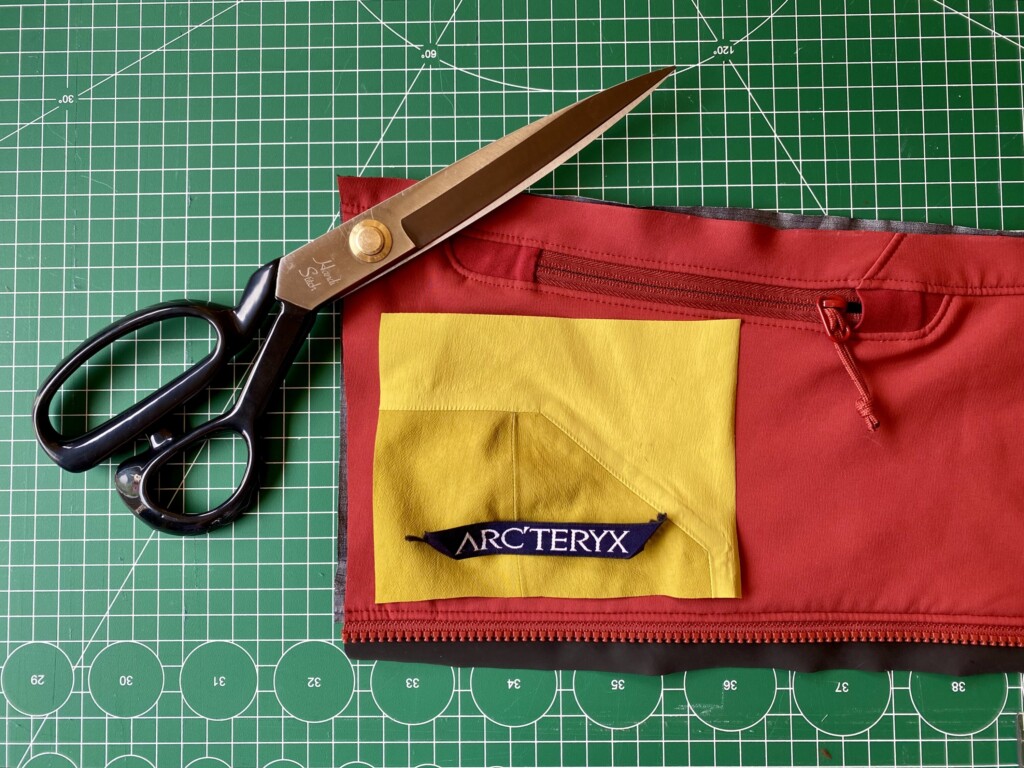
Story • Hannah Mitchell • Jul 28, 2023
Reframe, Engage, Create Change
How Arc'teryx's ReBIRD program is engaging consumers with the concept of circularity in the outdoor clothing industry
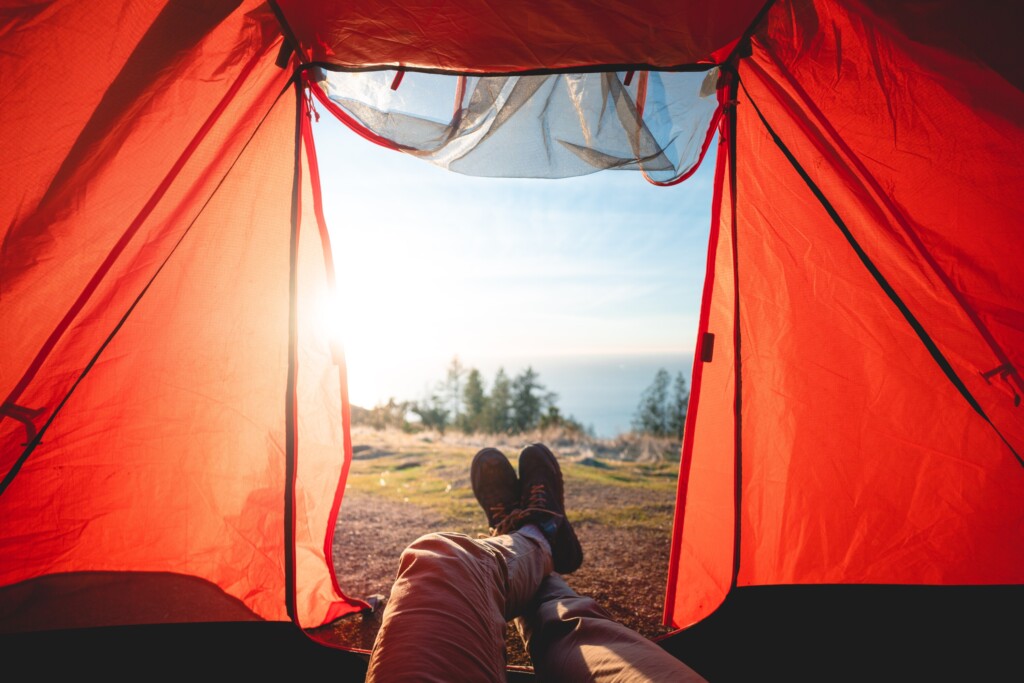
Story • Hannah Mitchell • Jun 27, 2023
The UK’s Best ‘Almost Wild Camping’ Spots For 2023
Back-to-basics camping and wild vibes... but with a few added comforts
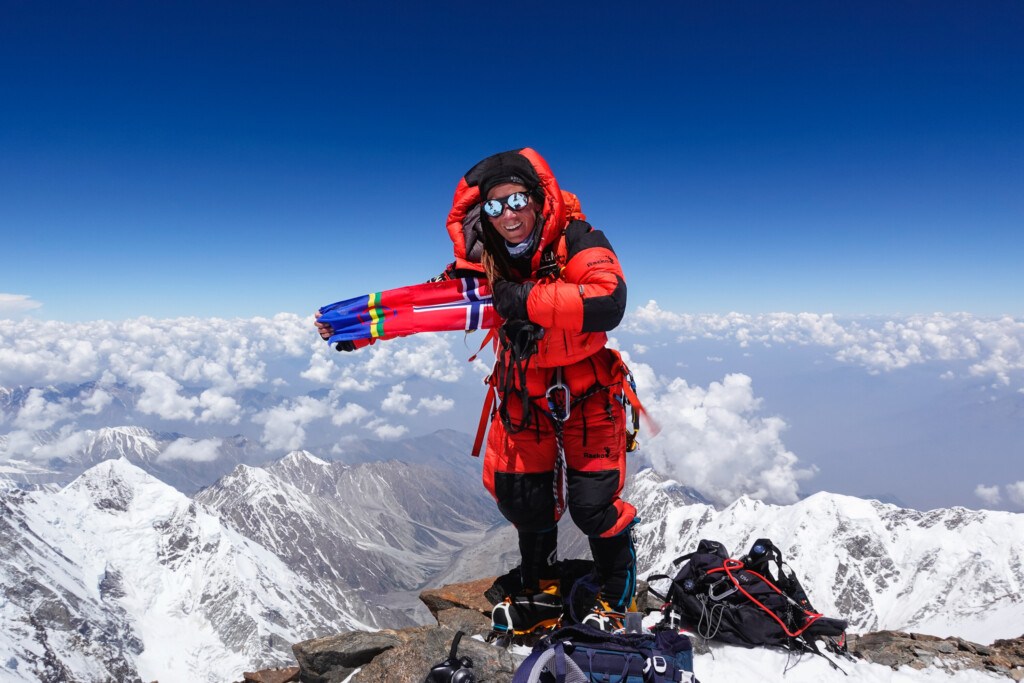
Interview • Hannah Mitchell • Jun 13, 2023
Chasing The 14: The Kristin Harila Interview
In conversation with record-breaking Norwegian mountaineer and Osprey ambassador, Kristin Harila

You might also like
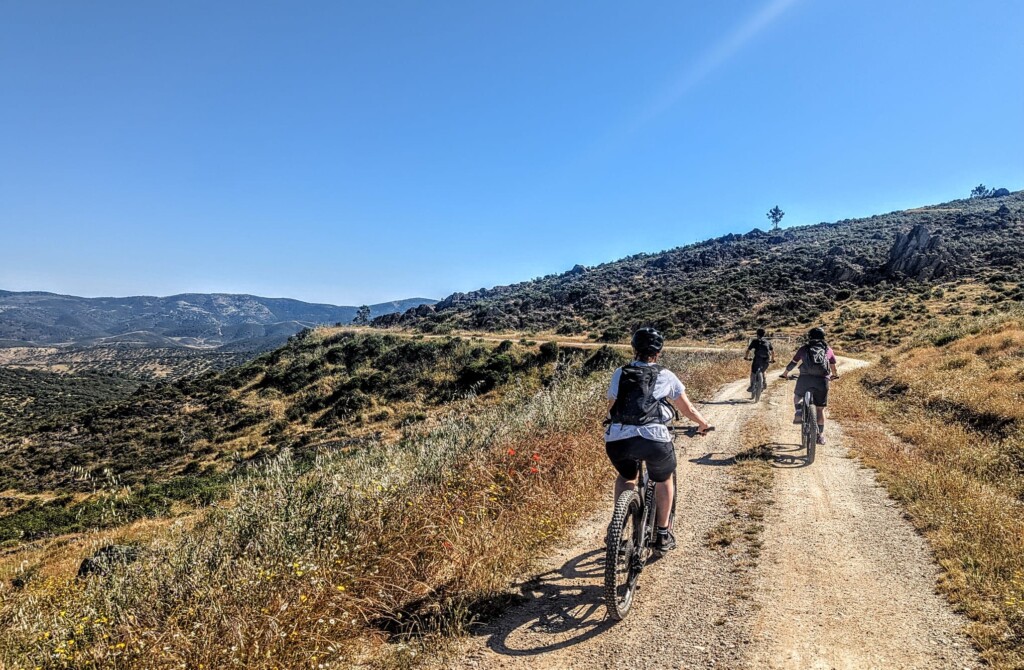
Story • Matthew Pink • May 30, 2025
Smuggler lanes and donkey trails: e-MTB in Andalusia
Hazy days zig-zagging the Andalusian sierra through a mesh of secret trails
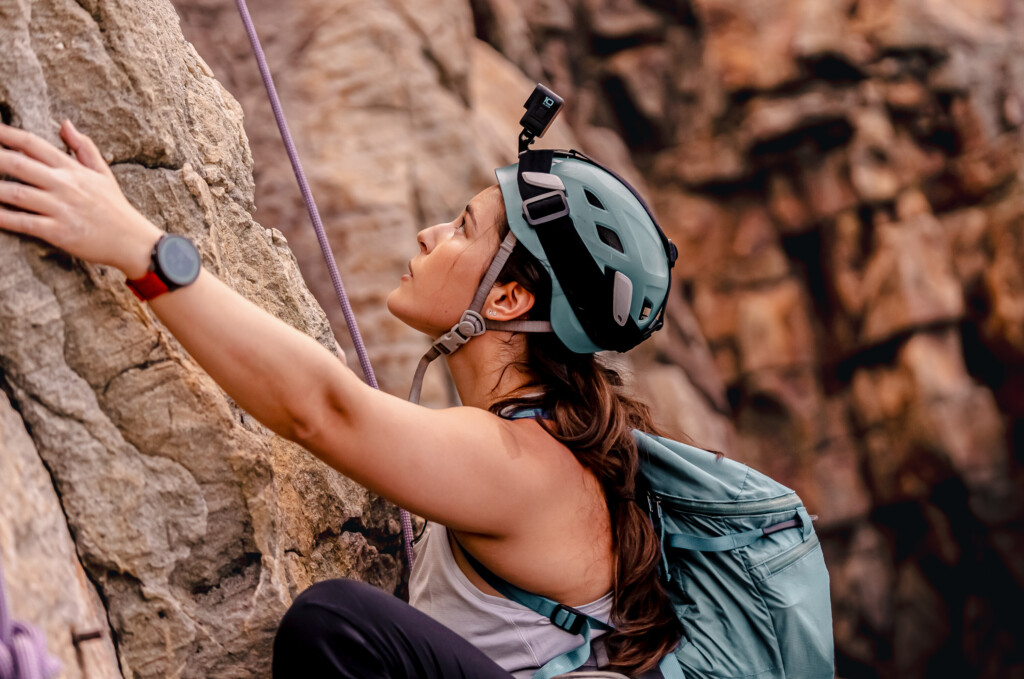
Photo Essay • BASE editorial team • Mar 18, 2024
Hunting happiness through adventure in Taiwan
BASE teams up with adventurer Sofia Jin to explore the best of Taiwan's underrated adventure scene.
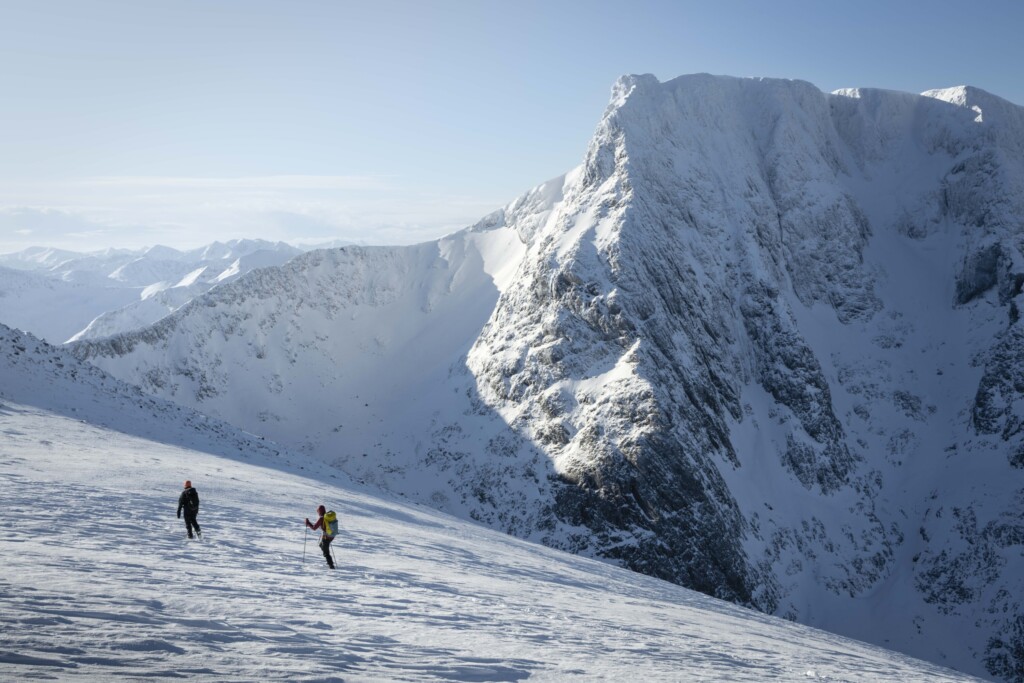
Story • BASE editorial team • Nov 21, 2023
Five Epic UK Climbs You Should Try This Winter
Craving a snowy mountain adventure? Inspired by the Garmin Instinct 2 watch (into which you can directly plan these routes), we've compiled a list of five of the best for winter 2023-24!


